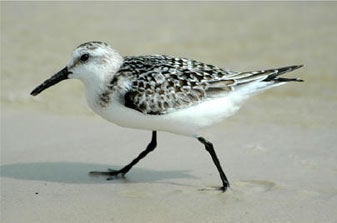SCIENTIFIC NAME:
Calidris alba
STATUS:
Common in winter, spring, and fall, fairly common in late summer, and uncommon to rare in early summer in Gulf Coast region. In other regions, occasional to rare in spring, and rare to uncommon in late summer and fall. Low Conservation Concern.
DESCRIPTION:
The Sanderling is a medium sized shorebird that is approximately the size of a robin. Average length is 6 inches, with a wingspan of approximately 14 inches. This shorebird has a prominent white wing stripe that changes during the season. Summer plumage of this species is brownish gray. During the winter months, plumage turns to a grayish-white coloration. This shorebird possesses a dark black pointed bill, black legs and a white belly.
DISTRIBUTION:
The sanderlings breeding grounds are in the arctic. This shorebird also breeds in areas along the northern coast of Alaska. Non-breeding populations of sanderlings can be located in the summer months as far south as the beaches of Argentina and Chile. Sanderlings are commonly found along the beaches of the Gulf Coast.
HABITAT:
On its breeding grounds in the tundra regions of North America, sanderlings prefer low rocky tundra. These are usually adjacent to either the coast or near inland lakes or ponds.
During the remainder of the year, sanderlings can be located near or on beaches throughout its range. They generally prefer coastal regions that are wave swept; but have been known to frequent rocky shoreline or associated wetlands.
FEEDING HABITS:
Feeding habits of this shorebird are humorous to watch while darting in and out of oncoming waves in a manner that can only be described as frantic. Food items such as small mollusks, crustaceans, crab eggs, aquatic invertebrates, insects and worms can all be obtained before the next wave sends the sanderling to higher ground.
LIFE HISTORY AND ECOLOGY:
Sanderlings arrive at their breeding grounds in May or June. Preferred nesting sites are adjacent to coastal regions of the tundra. A typical nest consists of a hollowed depression in the soil that is lined with lichens and grass. After a short courtship; females lay a clutch of 3-4 earthen colored eggs. Incubation typically is accomplished by both parents for 24 to 31 days. Shortly after hatching, the chicks leave the nest and begin foraging for insects. Both parents will stay with the chicks for at least 20 days. Chicks generally fledge the nest after they are 17 days of age. Adults leave the breeding grounds early, leaving the young to migrate on their own.
Sanderlings can be recognized by their frantic feeding behavior. Running down to the water’s edge with an outgoing wave and then racing back up the beach to avoid the next incoming wave. They are a common site along the beaches of the Gulf Coast.
REFERENCES:
http://www.nhptv.org/natureworks/sanderling.htm
Peterson, R. T. 1947. A field guide to birds, pp. 75.
Author:
Michael E. Sievering, Division of Wildlife and Freshwater Fisheries






